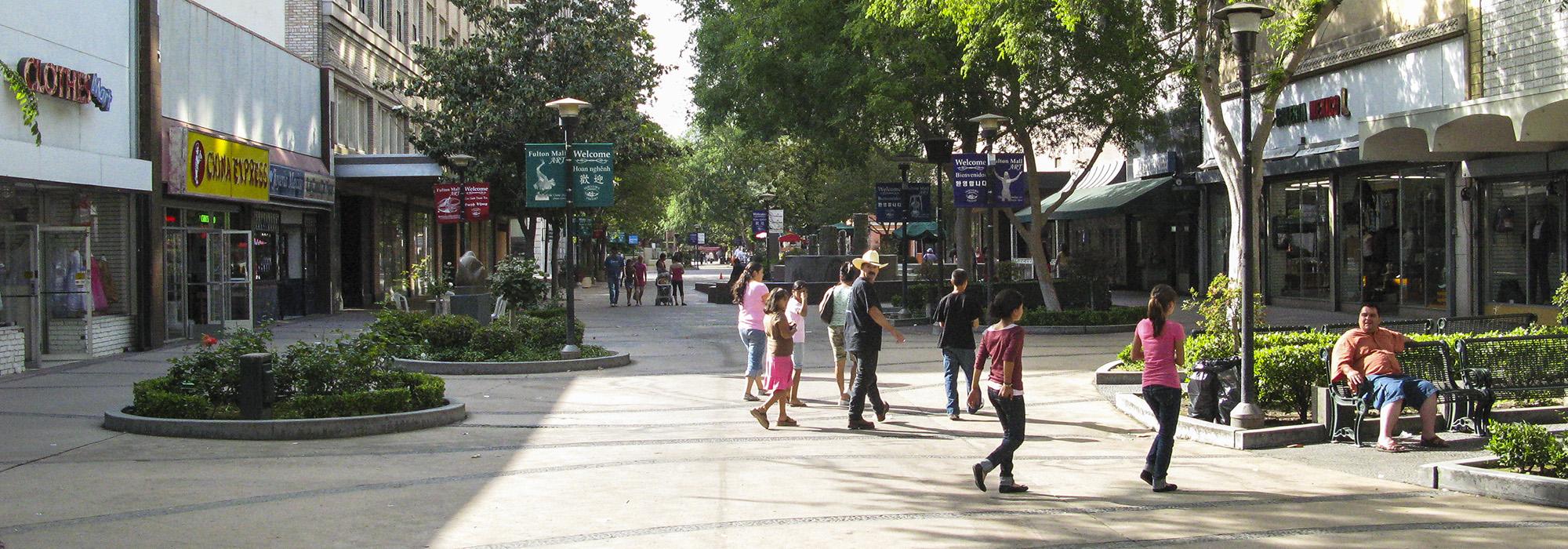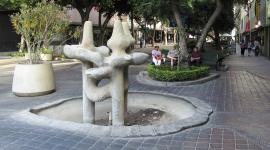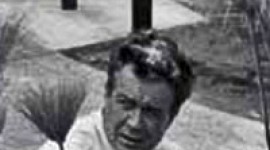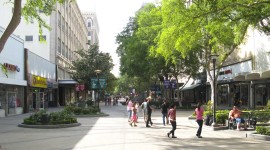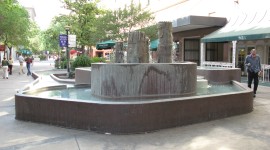Eckbo's Fulton Mall is Under Threat

Designed by Garrett Eckbo (completed 1964), the Mall was originally the centerpiece of an effort to maintain downtown Fresno as the region’s retail center. Now, it's threatened as the city seeks to change the face of downtown.
Fresno, California’s Fulton Mall, designed by Garrett Eckbo, arguably the leading theoretician and practitioner of 20th-century modernist landscape architecture, was completed in 1964. The Mall was originally the centerpiece of an effort to maintain downtown Fresno as the region’s retail center. Changes in planning policies from centralization to decentralization created an orgy of urban sprawl dooming that effort. However, thanks to the genius of Eckbo’s design, Fresno was left with an urban park.
Since 2002 the Fulton Mall has been threatened with destruction by a determined minority that is convinced that turning it back into a street will create a thriving retail center. The controversy over the Mall has reached a point of crisis: a nomination of Fulton Mall to the National Register of Historic Places is on the agenda of California’s State Historical Resources Commission on July 25.
History
Fulton Mall had its origins in an effort to reverse the decline of downtown Fresno as the region’s retail center. The architectural and planning firm Victor Gruen Associates was retained to provide a unified design for the downtown area. Gruen’s plan for the city of Fort Worth, although never implemented, had earned him a prominent position in the urban renewal movement. One of the seven guiding principles of the plan, as quoted in Gruen’s book, Centers for the Urban Environment: Survival of the Cities, is “Exclusion of the private automobile, and radical reduction of all other surface traffic within the core, with the remaining traffic operated either electrically or by some other environmental-friendly method.”

Gruen’s Fort Worth plan became the model for his revitalization plan for Fresno and he engaged landscape architect Garrett Eckbo to design the pedestrian mall that would become the centerpiece of the master plan. Eckbo’s first book, Landscape for Living (1950), had earned him widespread professional recognition and established him as probably the principal theorist on modern landscape architecture. Throughout his career he continued to explore ideas and explain his practice in print, publishing seven books and dozens of articles. In addition to maintaining his design practice, Eckbo had an academic career, first at the University of Southern California, and finally as Professor and Chair of the Department of Landscape Architecture at the University of California, Berkeley. The more than twenty awards given to Eckbo, including the Medal of Honor awarded in 1975 by the American Society of Landscape Architects, testify to the widespread recognition of his achievements.
One indicator of Eckbo’s prominence in 20th Century landscape architecture is the amount of attention he is given in the 1993 volume, Modern Landscape Architecture: a Critical Review, edited by Mark Treib. Of the twenty-three selections included in the book, eight are either by Eckbo or about his work.
|
|
 |
From conception to completion Garrett Eckbo’s aesthetic theory came to complete fruition in the Fulton Mall. It was a project he took particular interest in and as Marc Treib, Eckbo’s biographer has written, it “remained one of Eckbo’s favorite projects and the one of which he was most proud.”
Fresno’s Fulton Mall is considered to be one of Eckbo’s major achievements. It set a high standard for civic design in the nation’s downtown urban renewal efforts and immediately received worldwide attention and acclaim. In his article “The City that Puts People First” (McCall’s, April 1966), Bernard Taper reported that more than fifty cities sent official delegations to see it.
The Fulton Mall complex was created from six blocks of Fulton Street as well as some short segments of three of the streets that transect Fulton. Two other streets crossing Fulton continue to bear traffic and divide the Mall into three equal portions. The major six-block portion of the Fulton Mall is 2,670 feet long. Together with the three shorter cross malls, the total length of the Fulton Mall complex is 4,620 feet. Every right-of-way in the complex is eighty feet wide, constructed of concrete stained to suggest the soil of the San Joaquin Valley. Ribbons of concrete aggregate eight-and-one-half-inches wide cross each right-of-way at frequent intervals, sometimes gently curving and sometimes angular, suggesting the contours of the valley floor. Interspersed throughout the Mall are the following: 144 trees and a large number of shrubs and flowers in planting beds of many shapes and sizes and elevations; nineteen sculptures; eighty seating areas of various sizes and configurations, eighteen of which have benches with brightly colored mosaic backs; two tot lots; nineteen water features, among them pools, fountains and flowing streams; and twenty-six sculpted ceramic pipes that are part of the water features. All of these elements are arranged in a harmonious whole. The modernity of the Mall is tempered by the presence of several early twentieth-century buildings along it that comprise what one scholar has called an “almost unique assemblage of Beaux Arts Classical office buildings. . . .”(Early Tall Buildings by Dickinson Weber).
Today the Fulton Mall complex retains its integrity. The Mall’s trees have matured, providing more shade and greatly increasing the park-like character of the Mall. The two tot lots, one near each end of the Mall, were refurbished this year to comply with A.D.A. standards. Other changes include the replacement of most of the original wooden benches with metal ones, the conversion of one water feature into a planter, and a change in the design of the light fixtures.
Threat
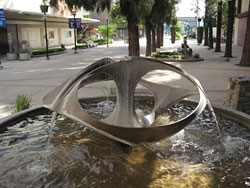

Image © Tim Davis (2008)
Fresno’s Fulton Mall has been under threat since 2002 when a small number of Mall business owners and the Fresno Redevelopment Agency attempted to return vehicular traffic to the Mall. The plan would have eliminated most of the trees and fountains, forced the removal of the sculptures, violated the Mall’s integrity, and almost totally obliterated its function as a social meeting place and urban park. A large outpouring of public resistance to this proposal, including ninety percent of business and property owners on the Mall, persuaded the Fresno City Council, sitting as the Redevelopment Authority, to abandon the plan in May 2002. But the proponents of returning vehicular traffic to the Fulton Mall have not given up. The project continues to be a line item in the City’s budget, although unfunded, through 2008. The Redevelopment Agency has recently incorporated two blocks of the Fulton Mall in a proposed redevelopment project. In March 2006 Fresno’s City Council passed a motion directing staff to conduct a study that would make it possible for the Council to decide “how to proceed with the Fulton Mall.” A series of meetings were held during the summer of 2006 to allow citizen comment on what to do about the Mall. Of those citizens who specifically addressed the issue of whether or not to return traffic to the Mall, all but a handful stated that they wanted Fulton Mall to remain a pedestrian-only space. The proponents for vehicularization seem to be undeterred in their goal, however.
An application nominating Fulton Mall for the National Register of Historic Places has been placed on the July 25 agenda of the California State Historical Resources Commission. Following the recommendation of city staff, which claimed there had been insufficient time for public review and comment, the local Historical Preservation Commission on June 23 chose to postpone a discussion of the application on its merits and voted to oppose the nomination for the time being.
How to Help
Write a letter in support of nominating Fulton Mall to the National Register of Historic Places. Letters should be addressed to:
California Department of Parks and Recreation
Office of Historical Preservation
State Historical Resources Commission
P. O. Box 942896
Sacramento, CA 94296-0001



